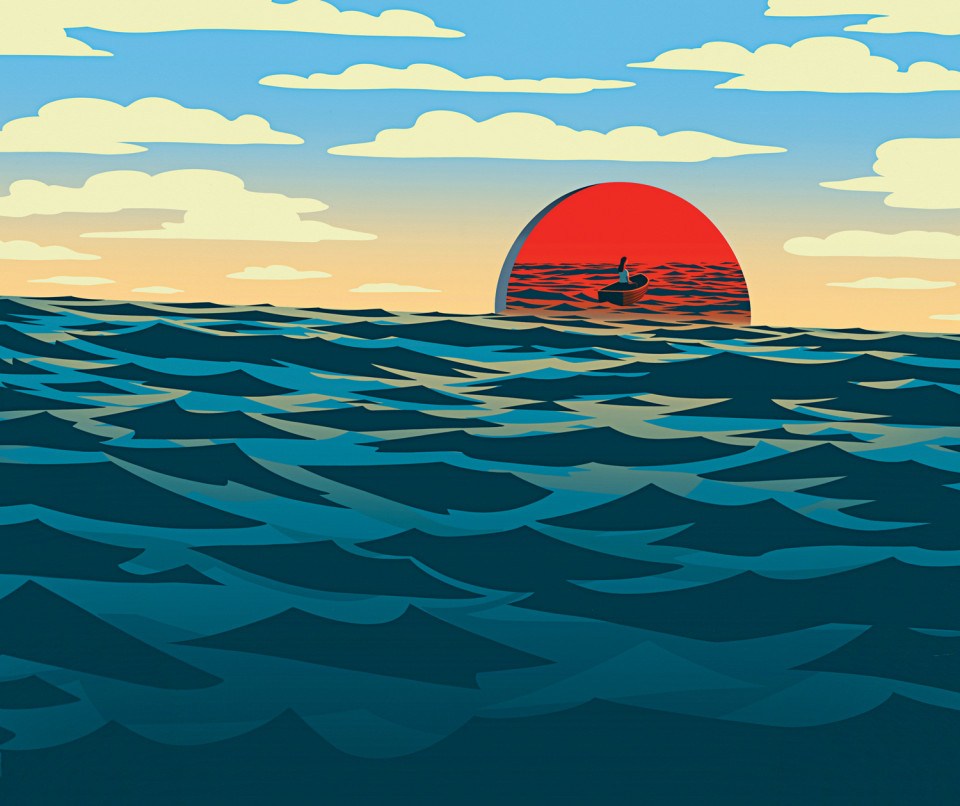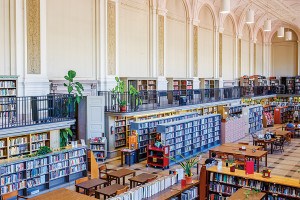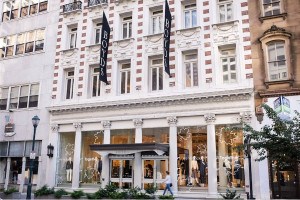How the Pandemic Rewired My Sense of Place and Time
Years after lockdown, the world looks familiar — and yet completely changed.

Post-pandemic life: disoriented, nostalgic, and questioning what’s real in a world that no longer feels like home. / Illustration by Jon Krause
In general, I’ve lived a long and happy life. Sure, there have been intervals of hardship — I lost my mother and a sister too soon; there hasn’t always been enough money; there have been health challenges now and again. But until fairly recently, I had no real reason to complain.
That lucky streak ended when COVID swept in.
Oh, I got the disease, like almost everyone else I knew. But my case was mild, and then the vaccines came through, and I haven’t been struck again since. No, my problems arose from the absurd, abrupt changes the worldwide pandemic triggered in my quiet life.
What had been decades of steady routine — wake up in the morning, grab coffee, drive into the city from my distant suburb, hang out in an office with plenty more (free!) coffee and a couple dozen smart, engaged, hardworking colleagues, finish the day’s tasks, drive home, and settle in for some Phillies or Sixers — suddenly shrank down to just me, sitting at my kitchen table with the laptop and the cat. There was still coffee — at least, when the grocery store wasn’t all picked over. And the colleagues were still there, albeit as disembodied faces on Zoom. But nothing about the world seemed at all the same.
Where I’d once been (relatively) easy-going, I became paranoid, eyeing strangers with intense suspicion — not really surprising when you consider that anybody could be harboring a deadly disease. And, um, I’m ashamed to say that I turned into a bit of a hoarder. I needed that extra 12-pack of toilet paper, damn it! It was worth it to me to drive all the way to Delaware to pick up a case of my favorite wine — or maybe two — just to be sure I’d have it on hand while our state stores were in even more than their usual disarray. Like many other aging boomers, I’d grown up a child of plenty, unaccustomed to doing without, and this weird new world’s demand that I adjust my thinking made me resentful. This was America, the land of goddamn milk and honey. How could there not be any lime-flavored Polar seltzer on the Wegmans shelf?
So we all hobbled along, month after month, year after year. The supply chains eventually got (mostly) unkinked. The masks (pretty much) came off. Schools (generally) opened up again. The world came to resemble what it had been in the before times … and yet in some profound ways, it did not.
The strangest manifestation of this for me was that I found myself … well, lost. My husband and I have lived in the same house in the same small town for 30 years now. It’s where we raised our two kids, walked our large dog, went to parent-teacher conferences and Scout meetings and soccer games and band concerts for three whole decades. And yet for some reason, my surroundings had become utterly unfamiliar to me. I had trouble navigating my way to the mall I once knew like the proverbial back of my hand. I got disoriented trying to take my car to the auto-body shop. I couldn’t find the doctor’s office. I didn’t recognize the exit of the Schuylkill Expressway I once took to the office. Every. Single. Day.
I’d been cut loose from the moorings of the familiar, the accustomed, the cozily insular life I’d led seemingly without even thinking about it. Everything required so much energy and planning and work now, from rustling up Thanksgiving dinner to scheduling a dentist appointment to going for a walk with a friend. It was as though my brain had short-circuited because it was overloaded. There was so much more to worry about all the time!
And then, in a strange, haunting corollary, I became aware of another, completely oppositional phenomenon, this one of familiarity. I’d be driving to visit my son or daughter or to see an old friend or to a garden center I’d heard was worth a stop, and along the way, I’d be overcome by a sense that I had been right here, driven right here, sometime in the past, for some reason I couldn’t quite put my finger on. Where might I have been going, though, way out in these lower stretches of Chester County? Hadn’t I stopped and waited at this Delco red light once before? The world around me had become a palimpsest, mapped over and over with the flotsam of a million jumbled memories. That’s what 40-plus years of journalism work will do, with layer upon layer of stories and visits and interviews heaped atop one another.
Surely I had visited that obscure nature center in Audubon before — perhaps for my article on peregrine falcons, or the one on bird-watching? Surely the Philly Mag staff did once hold a COVID-era meetup at this WeWork space? I once drove beneath this very bridge on my way to interview a college-admissions director for a story … or did I? Maybe I was only imagining it. One thing I’m sure of, though: The world looks irrevocably different to me these days.
I wonder sometimes if this is what it was like to live through the cataclysm of Vesuvius’s eruption, or the Black Death, or America’s yellow fever epidemic, or in Syria or Sudan today — in times when one’s neighbors inexplicably, irretrievably disappear or simply turn up dead. RFK Jr. notwithstanding, the wonderful world of science had largely eradicated most forms of wholesale medical extinction. We’d all been spoiled by its successes against an entire portfolio of once-fatal diseases, not to mention the expanded nutrition we enjoyed thanks to the (relatively) cheap availability of an amazing range of foodstuffs: avocados from Mexico! Bananas from Brazil! Swedish fish and South Seas shrimp! We simply weren’t used to having to fret about such things. Yet here we all (mostly) were, tightening up the laces of our N95 masks.
Just before Thanksgiving, an old friend and I, searching for a place to take our weekly walks together now that winter was descending, headed for that local mall I was having trouble finding. We parked outside a health-care center that sits where the Ross used to be and tried to get in. We couldn’t, because the doors were locked, so we tried the next set of doors off the parking lot, beside what used to be the toy store. They opened, but they led onto a long, empty hallway walled off at the far end. The third doors we tried were even more dispiriting; they gave onto more hallway, dirty and lined with barred, vacant storefronts and trash and construction detritus, with the occasional shriveled, browned potted fern or ficus to liven things up.
We finally gave up and went to what was once the mall’s crown jewel — its sole department store, Boscov’s, which at least was still open. There, we walked the aisles of linens and tableware and women’s clothing in near-solitude broken only by the occasional frighteningly friendly greeting of a salesperson. All the store’s entrances to the remainder of the mall were sealed off tight. The whole experience was downright post-apocalyptic. In my memory, those hallways were thronged with cheery holiday shoppers. The high-school choir annually performed Christmas carols here; it was where we bought birthday gifts, and where my kids begged to be driven on Friday nights, to roam with friends through the Limited Too and Claire’s and the video-game arcade.
In my present stage of life, I can understand why nostalgia could be considered a malady. It paralyzes you, makes you unable to move forward, because you’re too occupied with remembering the past. Or trying to remember it, anyway.”
Maybe this is just what happens when you get old — the world changes so much in the space of your lifetime that you think, “This can’t be real.” I began my journalism career pounding on a typewriter; now, the machine I type on is connected to the whole wide world. It could be that at my point in life, you’ve had so many experiences, seen so many things, that everything reminds you of something. I used to listen to the radio on my three daily hours of commuting, and all that music only augmented the vast catalog in my memory of the most random assortment of songs. The oldies station that played the Beatles and Rolling Stones and Dylan, the “contemporary adult” one with Adele and Phil Collins and Lionel Richie, country songs by Kenny Chesney and Miranda Lambert — add in my adolescent crushes the Monkees and the entire Episcopalian hymnal, plus my dad’s repertoire of World War I and II rousers, not to mention numbers from all the musicals my parents used to take us to at Valley Forge Music Fair, and there’s a whole tune-iverse stuffed inside me. Songs pop into my head as I sit and sip my coffee, and I sing them out loud in the silence of the kitchen, startling the hell out of the cat. It’s like floating along on a wide Mississippi River of music all day long.
In Becca Rothfeld’s recent Washington Post review of Agnes Arnold-Forster’s book Nostalgia: A History of a Dangerous Emotion, I learned that the condition was originally considered an illness — a “potentially fatal” one. The word was coined by an Alsatian physician, from the Greek nostos, meaning “homecoming,” and algos, Greek for “pain,” to describe the homesickness felt by European soldiers who were away at war. There was nothing warm and fuzzy or Disneyfied about it; doctors ameliorated it with “bloodletting and purgatives,” Arnold-Forster says.
Now, in my present stage of life, I can understand why nostalgia could be considered a malady. It paralyzes you, makes you unable to move forward, because you’re too occupied with remembering the past. Or trying to remember it, anyway. Man oh man, this stretch of highway, this curve, this fence — they all look so familiar! Haven’t I been here before?
You know who else has lost his temporal sense, per freshly retired New York Times opinion writer Paul Krugman? Our president, Donald Trump, who at age 78 recently took the helm of the nation again and is also, in this age of mainstream media obsolescence, The Only Person in America Who Still Cares About Being Time’s Person of the Year. In October, Krugman wrote about how so many of Trump’s pet causes — urban decay in Detroit, widespread blackouts (per Trump last year, “In California, you have brownouts or blackouts every week. And blackouts, I mean, the place is stone cold broke, no electricity”), rampant crime in New York City — did matter in the distant past, but these are no longer real concerns. After he points out that Trump routinely insulted the intelligence of other candidates during the last election, Krugman wonders what our president might have said about “an opponent … who regularly describes America in ways that suggest that he doesn’t know what year it is.”
And speaking of reality, what can one say about the president’s cabinet choices, most of whom, more than one observer has declared, are more fit to appear in a reality-TV show — Mehmet Oz in charge of Medicare and Medicaid? Linda McMahon heading the Department of Education? Tulsi Gabbard doing anything at all? — than to serve in the government?
In our president’s defense, the urge to immerse oneself in an alternate universe may be surprisingly common. Though it would be presumptuous of me to think I deserve to live in a world without woe, this one here does seem a little too much nowadays. In the New York Times recently, in a piece on the “epidemic of loneliness” many experts have diagnosed in America, University of Chicago professor Shannon Lee Dawdy, who studies human reactions to living through trauma, proposed an explanation for why so many Americans voted in favor of Trump’s reelection: “I think what they’re trying to do, some of them, is to reset the clock to 2016, before COVID.” God knows it’s an understandable impulse.
And it certainly would apply to me — not that I voted for him! — as I increasingly turn away from current events to explore instead the dusty dresser drawers of my memories. In my mind, I try to retrace the path I took walking to first grade back at Glenside-Weldon Elementary School in 1962, or the layout of my college dorm room at Duke, or the stairs from the choir rehearsal room to the narthex of the church I went to as a teenager, back when I still believed God had a hand on the world. It was a band called Simple Minds that ominously warned, “Don’t you … forget about me.” There surely is beneath my tsunami of nostalgia a profound longing for less complicated and far more certain days.
I don’t think we’re going to get them back again, though. I think it’s more likely that the tumult will just worsen — that whatever center might once have had a hell’s chance of holding will instead explode into a kazillion splintering shards of chaos and gloom that will be the Ultimate Showman’s ultimate show. He’ll likely admire the spectacle, the way the dinosaurs gazed in awed wonder as a celestial conflagration enveloped them, too dumb and numb to care.
Then again, we’ll all be.
In February of 2023, in the aftermath of the pandemic, someone, for some reason, sliced through the wire surrounding the enclosure of a Eurasian eagle-owl at the Central Park Zoo. The eagle-owl, a native to Europe, Asia, and parts of Northern Africa who’d been born in a North Carolina bird park prior to his bright-lights-big-city move to NYC, had lived for 12 years in the enclosure, which was the size of a bus stop. His habitat included faux rocks, tree branches, and a painted backdrop. He had a six-foot wingspan. And he climbed out through the hole in the wire mesh and flew away.
While New Yorkers watched in fascination, the bird, who’d been named Flaco (it’s Spanish for “skinny”), took stock of his surroundings. Never in his life had he needed to hunt and capture prey. In the New York Times, Michiko Kakutani described what his new life must have been like for him:
It was a kind of existential moment for the owl: his species is native to much of Europe and Asia, but not North America, and there he suddenly was, maybe the only one of his kind in the wild on the entire continent. In his first hours and days outside the zoo, Flaco “looked stressed,” said Karla Bloem, executive director of the International Owl Center. Even his flying was a little wobbly at first, she suggested; like “someone who’s been living in their living room” for years.
Or, perhaps, working at her kitchen table. Flaco promptly became a cult hero, his doings chronicled by a bevy of birders and duly reported on social media: He was catching rats! He was pilfering pigeons! Like an aerial Jesse James, he managed to evade every attempt by zoo officials and worried conservationists to trap him, put an end to his newfound freedom for his own safety’s sake. In his unmated solitude, he became a symbol of our widespread lonely COVID isolation. As Dr. Ruth Westheimer put it, “Flaco is limited in his choices by Mother Nature, though he’s not giving up, flying all over New York to find companionship.”
Just a month before Flaco’s escape, HBO had premiered a new TV series called The Last of Us, set during a pandemic caused by a fungus that turned those it infected into zombies. It’s no coincidence that it was one of the network’s most-watched-ever series debuts, as it introduced a cast of misfits — a smuggler, a teenage girl, a handful of resistance fighters dedicated to freedom. Like Flaco, The Last of Us proved the perfect metaphor for the uncanny, unintelligible circumstances in which we all abruptly found ourselves. We may be wearing masks less these days, but we haven’t recovered our equilibrium. It’s still so hard to trust anyone.
We’re all freaks in our world anymore — lonely wanderers in apocalyptic surroundings, searching for support, for loved ones, for an escape and a way home. Flaco’s brave resistance was short-lived; he was found dead a year after his daring escape, weakened by ingesting too much rat poison via his verminous diet and finally done in by a collision with a building. Fans from all around the world mourned his demise.
I feel myself more and more these days like Flaco, marveling at how the world around me resembles the one in which I used to live and yet, the more closely I look, doesn’t. Who knows who will be the last of us? Maybe I really am a creature of these times.
Life is so completely linear until suddenly it isn’t — until you find yourself immersed in loops of what happened when you were five, and then when you were 25, and then 55, and it’s completely unnerving, because you’ve always learned — you’ve always believed — that time moves in a certain way, and as it turns out, it’s not that way at all.
So the question I find myself asking, like poor Flaco, is: Which is the real world? The cage we see, that we lived in contentedly for so long, or the one that now surrounds us, that we don’t?
Published as “Weird New World” in the March 2025 issue of Philadelphia magazine.


